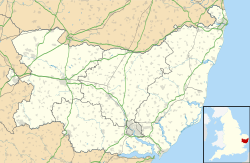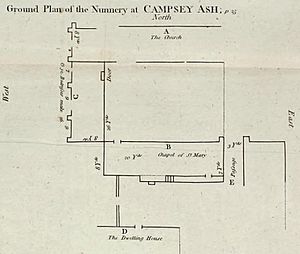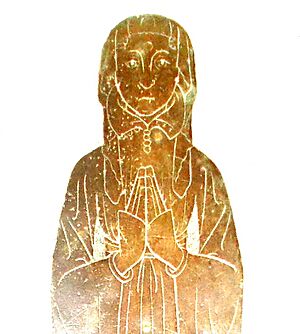Campsey Priory facts for kids
| Monastery information | |
|---|---|
| Order | Canonesses Regular of St Augustine |
| Established | by 1195 |
| Disestablished | 1536 |
| Dedicated to | House of the Blessed Virgin Mary |
| Diocese | Norwich |
| People | |
| Founder(s) | Theobald de Valognes II |
| Important associated figures | Maud of Lancaster, Countess of Ulster |
| Site | |
| Location | Campsea Ash, Suffolk, England |
| Coordinates | 52°08′23″N 1°23′11″E / 52.1396°N 1.3865°E |
| Visible remains | possibly parts of chaplains' house |
| Public access | no |
Campsey Priory was a special religious house for women called canonesses. These women followed the rules of St. Augustine. The priory was located in Campsea Ashe, Suffolk, England.
It was started around 1195 by Theobald de Valoines II. He founded it for his two sisters, Joan and Agnes. Theobald had also helped start Hickling Priory for men in 1185. Both Campsey Priory and Hickling Priory were closed down in 1536. This happened during a time when King Henry VIII was closing many monasteries in England.
Campsey Priory was connected to other important monasteries nearby. These included Butley Priory and Leiston Abbey. These places were often linked through powerful families, like the de Valoines and later the de Ufford families.
One very important person connected to Campsey Priory was Maud of Lancaster, Countess of Ulster. She was a strong supporter of the priory. She even helped create a new religious house, Bruisyard Abbey, which started from Campsey.
Today, most of the original buildings are gone. Some parts were taken apart and used for other buildings. The site is now a private home, so you can't visit it. However, some old records and books from the priory still exist.
Contents
Starting the Priory
Theobald de Valoines II inherited his father's lands in 1178. Before 1195, he gave some land at Campsey to his sisters. Joan and Agnes de Valoines wanted to build a home for themselves and other religious women. This new home was dedicated to Mary, the mother of God.
King John officially approved these gifts in 1203 or 1204. Theobald died around 1209. His son, Thomas, later joined a group of barons who fought against King John. Because of this, Thomas's lands were taken away for a short time.
The nuns chose a quiet place for the priory. It was easy to reach by river and road. This meant they could get supplies and travel to important towns nearby. The area also had many natural resources. The priory was built on the east bank of the River Deben.
Prioress Joan de Valoines
Theobald's sisters, Joan and Agnes, built the priory. Joan de Valoines became the first prioress, or leader, of the community. The priory was definitely active by November 1195. At that time, a man named John Lestrange gave the church of Tottington to the nuns of Campsey.
Joan was prioress for a long time. In 1211, she gained full control over the Tottington church. In 1221, Thomas de Valoines gave more land at Parham to Joan for the priory.
Around 1228-1230, Prioress Joan had a disagreement with the leader of Butley Priory. They argued over who should get the tithes (a type of payment) from a church in Norfolk. The Pope eventually got involved. In the end, the tithes were given to Butley Priory.
Patrons and Prioresses
Joan's sister, Agnes, became prioress by 1234. Later, Robert de Valoines, the heir of Thomas, became the priory's patron. A patron was someone who supported the priory with money and influence.
The Campsey nuns didn't want Robert to be their patron at first. But between 1244 and 1257, they reached an agreement. The nuns accepted Robert and his family as their patrons. In return, Robert promised they could choose their own prioress. He also agreed not to sell their lands if the priory was without a leader.
Robert de Valoines died around 1268. His young daughters, Roisia and Cecily, became his heirs. Cecily later inherited the role of patron for Campsey Priory.
The Priory Buildings
The priory church and other buildings were likely built in the early 1200s. In the late 1700s, some ruins were still visible. People tried to draw a plan of the buildings. This plan showed a cloister yard, which was an open space surrounded by covered walkways.
The main church building was usually on the north side of the cloister. In 1970, excavations confirmed where the cloister was. They also found parts of a small chapel next to the church. Many old tiles were found, similar to those at nearby Butley Priory.
The south building was likely the refectory, or dining hall. It was still quite tall in 1785. A painting from that time shows tall arched windows. This building probably had a special stand for reading during meals.
The nuns at Campsey Priory spoke Anglo-Norman, a type of French. An important book from the priory is called the "Campsey Manuscript." It contains stories of saints written in Anglo-Norman poetry. This book was read aloud during meals in the refectory.
The book includes stories about important saints like Thomas Becket and Edward the Confessor. It also has stories about saints from East Anglia, where the priory was located. This collection was put together between 1275 and 1325.
The priory's 14th-century seal shows the Virgin Mary holding the Child Jesus. This image was a common symbol of Mary as the Mother of God. The seal also has a shield with a family symbol. The words on the seal say: "Priorisse et Conventus S. Marie de Campissey," meaning "Prioress and Community of St. Mary of Campsey."
Ufford Family Support
The Valoines Connection
Campsey Priory became connected to the Ufford family through marriage. Cecily de Valoines married Robert, Lord of Ufford, around 1295. The Ufford family was very powerful. They owned many lands and castles, including Orford Castle.
Cecily's inheritance, including the patronage of Campsey Priory, made the Ufford family even more influential. In 1306, Cecily gave the right to choose the priest for Helmingham church to her family's nunnery at Flixton Priory.
Lord Ufford died in 1316. His son, Robert de Ufford, became the next patron in 1318. Cecily died in 1325.
Special Prayers
Robert de Ufford became a favorite of King Edward III. In 1333, a special prayer service was set up at Campsey Priory. This was for a canon (a type of priest) and two helpers to sing daily masses. They prayed for the soul of Alice of Hainault, a countess who had died.
Robert was made Earl of Suffolk in 1337. His brother, Sir Ralph de Ufford, also gained royal favor. Sir Ralph married Maud of Lancaster. Maud was the widow of a powerful Irish leader.
Sir Ralph died in Ireland in 1346. Maud brought his body back to England. He was buried in a chapel at Campsey Priory church.
Maud decided to join the Campsey sisterhood. She arranged for five male chaplains (priests) to sing daily masses in the chapel. These prayers were for Ralph's soul and for her family. She was allowed to use income from her lands for one year. After that, the priory received a yearly payment for her support.
The College at Bruisyard
Campsey Priory had a small group of secular priests (not monks or nuns). They stayed at a nearby village called Ash until 1354. The Earl's brothers gave land for these chaplains to move to Bruisyard, Suffolk.
It was decided that the chaplains should move because they were old. The walk from Ash to the priory was hard for them. Also, their masses sometimes interfered with the nuns' singing. It was also thought that men and women should live separately.
So, in 1354, the college of chaplains moved to Bruisyard. They were to live, eat, and sleep together. They would also hold three daily masses in a new church there.
Countess Maud stayed at Campsey for another ten years. She wanted to avoid many noble visitors. So, she chose to live a more secluded life at Campsey. Her daughter Elizabeth died in 1363.
Later, Maud decided to join the nuns minoresses of St Clare. This was a different order of nuns. She moved to Bruisyard Abbey, which was refounded as a monastery for these nuns. The move was completed by 1366. Maud died in 1377 and was buried at Bruisyard Abbey.
Ufford Family Burials
Many members of the Ufford family were buried at Campsey Priory. Margaret, Countess of Suffolk, died in 1368. She was buried at Campsey Priory church. Her husband, Earl Robert, asked to be buried next to her when he died the following year.
His brother, Sir Edmund de Ufford, was also buried there in 1375. Floor tiles with his family symbol were found during an excavation in 1970. Maud de Ufford, a daughter of Earl Robert, was also a canoness at the priory.
William de Ufford, the second Earl of Suffolk, was buried in the priory's chapel of St Nicholas. He asked for a marble tomb there. He also said that if he died without a male heir, a special sword given by King Edward III to his father should be left at Campsey forever.
In 1382, William's wife, Isabella, made a religious promise at Campsey Priory. She promised to live a life of chastity (not remarrying) after her husband's death. Many important people, including bishops and nobles, were there to witness this.
In 1785, two damaged stone figures were found at a nearby church. They showed the family symbols of Ufford and de Valoines. One was a woman, possibly Cecily de Valoines. The other was an armored man, possibly the first Earl. These figures might have been moved from the priory.
During the 1970 excavation, parts of a tomb were found. It was a large marble tomb from the late 1300s. It was beautifully made with carved figures and shields. This might have been the tomb of the second Earl.
The Chaplain College Refounded
The chaplains were still at Campsey in 1381. In 1383 and 1390, the college for chaplains was refounded. This also provided for two more nuns. New rules were set in 1390.
A house was to be built within the priory grounds for five secular chaplains. They were to have common rooms, a dormitory, and a dining hall. They would celebrate daily masses for the souls of Robert and William de Ufford and their wives. These services took place in the chapel of St Thomas the Martyr. The rules said the chaplains should never enter the nuns' living areas.
Maria de Felton was prioress at this time. She died in 1394 and was replaced by Margaret de Bruisyard.
Isabella, Countess of Suffolk, continued to receive income from her husband's estate. When she died in 1416, she asked to be buried with him in the priory church.
The Later Prioresses
Records show Margery Rendlesham was prioress in 1446 and Margaret Hengham in 1477. The last years of the priory are known from visits by the Bishops of Norwich.
In 1492, Bishop Goldwell visited. He found everything in good order with Prioress Katherine and her eighteen nuns. The names of the nuns showed they came from old noble families. A prioress named Anna is mentioned in 1502.
The last prioress of Campsey was Elizabeth Buttry. She had been a nun there since before 1492. In 1526, the bishop visited again. The nuns said everything was fine, except that the choir books needed mending. The prioress and her twenty nuns were told to fix the books and try to get more nuns.
By 1532, there were only 18 nuns. Some nuns started to complain. They said the prioress was generous to visitors but stingy with them. They complained about the food, saying the meat was unhealthy. One nun said a bullock they were fed would have died anyway if it hadn't been killed.
The prioress, in turn, said the nuns spoke too much with outsiders. One nun said they were forbidden to speak to anyone outside the community unless everyone was together. She also complained that the nuns were not getting their yearly allowance of money.
Closing of the Priory
Campsey Priory was not a poor house. Even with fewer nuns, its income should have been enough to save it from being closed. However, the government's valuation in 1536 did not include all the priory's income. Because of this, the priory was seen as "smaller" and was closed in the first wave of monastery closures.
Officials made a list of all the priory's goods on August 29, 1536. This list gives us a last look at the priory church. It had silver items for the altar, like a cross, a censer (for burning incense), and a chalice (cup). There were also altar cloths, candlesticks, and an image of the Virgin Mary.
The Lady Chapel had a special altar decoration made of alabaster. In the room where vestments (special clothes for priests) were kept, there were five copes (cloaks). These were made of rich fabrics like crimson velvet and silk with gold birds and angels.
The priory also had silver salt cellars and other chalices. No other books besides the Mass-book were mentioned. The priory was well-furnished with beds, tables, chairs, and other furniture. There were also rooms like the Steward's chamber, the Parlour, and the Kitchen.
The priory had farm animals too: 10 milking cows, a bull, 10 horses, and two oxen. They also had hay and grain. The total value of all their goods was about £56. Elizabeth Buttry, the last prioress, was given a copy of this list. She died in 1546 and was buried in St Stephen's Church, Norwich.
After the priory closed, King Henry VIII gave the land to Sir William Willoughby in 1543. Later, the property was sold to different owners. Today, the site of the priory is a farmhouse. A nearby building, Abbey House, might include parts of the chaplains' living quarters.
Burials
Many important people were buried at Campsey Priory, including:
- Robert Ufford, 1st Earl of Suffolk
- William Ufford, 2nd Earl of Suffolk
- Christopher Willoughby, 10th Baron Willoughby de Eresby
Images for kids








